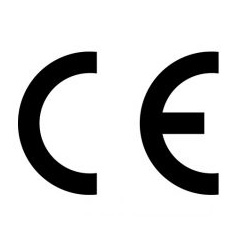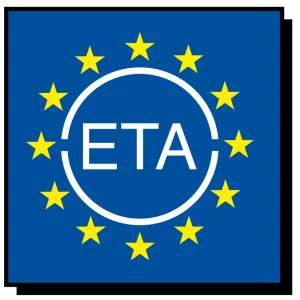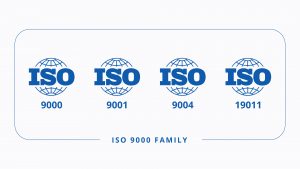
Mandatory
The CE mark is a mark that must be affixed to certain types of products who thereby certifies compliance (or conformity) with the essential requirements for marketing and use in the European Union established in the new approach directives. Trademark registration is required by law in order to be able to market the product in countries belonging to the European Economic Area (EEA). “Some directives may exclude the placement of the CE mark on certain products. [4] These products may circulate freely on the European market if they are accompanied, for example, by a declaration or a certificate of conformity. ‘[3] Examples of some directives that require the CE mark are the Construction Products Directive, the Low Voltage Directive, the Machinery Directive, the Electromagnetic Compatibility Directive, the Pressure Systems Directive, the Medical Equipment Directive. The full list is available at this address.
In the case of imports of products manufactured in non-EU countries (for example China), it is the importer who, before being placed on the market (even if it was a distributor if different from the importer himself), must verify compliance with directives. If the importer then sells on his own behalf within the EU, he must also redo the prescribed mandatory documents starting with the declaration of conformity. [5] Any liability relating to the branded product would however rest with the importer.
The CE marking is not mandatory for all products as European directives impose it only for certain categories. These include both products for strictly professional use (for example medical equipment, lifts, machinery and weighing instruments), and consumer products (such as toys, computers, mobile phones and light bulbs).
“The CE mark indicates that the product complies with all the Community provisions providing for its use”: [3] from design, manufacture, placing on the market, to the use of the product to disposal. The CE mark regulates the entire life cycle of the product from the moment it is placed on the market.
Member States may not restrict the placing on the market or putting into use of products bearing the “CE” mark, except in cases where the non-conformity of the product has been proven in court. The mark must be placed before the product is placed on the European market or put into service. “[3]
In addition to the free movement of goods, the CE marking attached to a product involves changing the burden of proof in accordance with the essential requirements set out by the New Approximation Directives. Given that products are placed on the market under the responsibility of the manufacturer or importer, the use of a legal fiction protecting the burden of proof means that a compliant product can only be challenged if the breach of the requirements of the reference Directive is concretely proven ( the so-called “presumption of conformity”).
By placing the CE mark on a product, the manufacturer declares that it complies with all the requirements for obtaining the mark itself, taking responsibility for its marketing within the European Economic Area (EEA countries, consisting of the 28 EU member states, and EFTA Countries, i.e. Iceland, Norway, Liechtenstein and Switzerland). The CE mark is also provided for goods manufactured in third countries, then marketed in the EEA and Turkey.
The CE mark does not mean that a product has been manufactured within the EEA area, but that it has been checked for compliance with the envisaged European regulations (for example, harmonized safety standards) before being marketed. In addition, the note indicates that the manufacturer has verified the conformity of the property with all the basic requirements of the relevant directives regarding safety, hygiene and respect for the environment. If the directives provide for it, the conformity of a product can also be assessed by a certified third party.
Technical harmonization.
CE marking was intended to remove obstacles to the free movement of products within the Single Market defined by the different product qualification systems contained in national laws referring to individual member states. [7] For this reason, a technical process of standardization has begun and is still under development, whose legal cornerstones are represented by Directive 98/34 / EC (the third revision of Directive 83/189 / EEC) and by Decision 93/ 465 / EEC (amended by Decision 768/2008 / EC). [8]
Directive 98/34 / EC provides for a procedure that obliges Member States to notify draft technical regulations related to products to the Commission and other Member States before they are adopted into national laws. [9] The so-called “98/34 procedure” ensures that the Commission has control over regulations
technicalities which may cause unjustified obstacles between different member states. To cite cases of Italian technical standardization, the Technical Standards for Construction (DM 14/01/2008) [10] are subject to this procedure as much as Legislative Decree 81/08 (Consolidated text on occupational safety). [11]
Decision 93/465 / EEC defines a series of procedures for assessing the conformity of industrial products with the essential requirements defined by the technical harmonization directives (ie called the new approach). The decision foresees eight assessment procedures (called modules) which are applied in the design and production phases of products which can circulate freely within the Single Market. [3]
New directives.
With the adoption of the so-called “new approach” the member states of the “European Union” have sought to break the barriers to the trade of certain goods by different technical rules among the co-signatories of the EC Treaty (Cassis de Dijon Judgment) [ 12]. The New Approach Directives consist of a technical harmonization work at a Community level, which aims to: establish EU technical standardization bodies, such as CEN (European Committee for Standardization), CENELEC, CEI and EOTA ( if the guidance documents for the achievement of the ETA are considered an act with the force of law), to which the production of specific product standards (called harmonized standards) can be trusted on behalf of the Commission;
governs only the general essential requirements of the products;
reducing the control of public authorities before placing a product on the market;
integrate quality assurance and other modern conformity assessment techniques [13].
Declaration of Conformity
The EC declaration of conformity is a certificate by which the manufacturer (resident in the European Community), the authorized representative (resident in the European Community and the only authorized representative of the non-European manufacturer) or the importer (resident in the European Community) certifies the conformity of a product with the essential requirements by drafting this declaration as clearly indicated in Annex IV of Directive 2004/108 / EC [29] and in the reference standard ISO / IEC 17050-1: 2004 [30] and subsequent updates.
Note that CE certificate and CE marking are two distinct concepts. As mentioned, only in very specific cases is it necessary to have an EC certificate (issued by notified bodies), as proof of passing the tests (tests, inspections, etc.) provided by the scheme or by the directive to achieve the CE mark.
In this sense, placing the CE mark on the product label presupposes that it is accompanied by a declaration of conformity, or a certificate according to the modules, which is the true binding document for the manufacturer, or the authorized representative or the importer. It is worth noting that those responsible for factory production control (equivalent to the quality manager or internal auditor for the CE marking of the product) are not ipso facto agents.
Scope of CE
active implantable medical devices;
gas equipment;
cableways for the transportation of people;
eco-modeling of products related to energy consumption;
electromagnetic compatibility measuring equipment;
devices for protection against explosive atmospheres;
explosives for civil use;
vertical road signs
hot water heating supplied by liquid or gaseous fuel;
domestic refrigerators and freezers;
in vitro medical diagnostic equipment;
elevators;
weighing instruments;
medical equipment;
equipment with noise emission in the environment;
non-automatic weighing instruments;
personal protective equipment;
pressure instruments;
pyrotechnic devices;
radio and telecommunication equipment;
hobbies and leisure products;
toys;
pressure vessel;
construction materials and products;
car.
Legal consequences
The CE marking of a product implies the assumption that it complies with European Directives [51]. The legal value of the CE marking includes:
not be subject to restrictions on the free movement of products in the area of the European Single Market, in accordance with Articles 28 and 30 of the EC Treaty;
reversing the burden of proof in accordance with the essential requirements laid down by the New Directives.
In particular, the last point is no small matter. Given that products are placed on the market under the responsibility of the manufacturer, representative or importer, using a legal fiction that protects the burden of proof means that a product subject to the CE marking can only be contested if the breach of the requirements of the Directive reference is actually judged in court.
In contrast, the violation of the obligations attributed to the CE mark or the unfair CE marking, if this is mandatory, requires the withdrawal of the product by the competent market surveillance authority [52] . Procedures and sanctioning measures provided for




